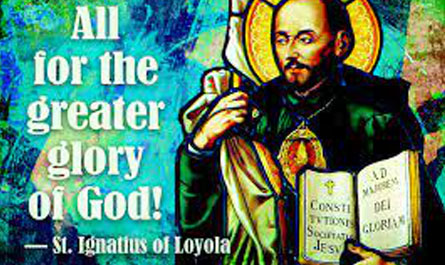By Gladyce Janky
In his autobiography, The Pilgrim, St. Ignatius of Loyola describes himself as a man who, until the age of twenty-six, was given over to the world’s vanities. Íñigo López de Loyola, born in 1491, aspired to be a valent soldier, winning the affection of noble women. In 1521 his military career ended at the battle of Pamplona with the shattering of his leg by a cannonball.
During his convalescence, at his brother’s castle, he escaped boredom by reading the only books available, the Life of Christ and The Lives of the Saints. He daydreamed about doing great works for God or returning to his old life. Journaling his emotional responses, he noticed a pattern of feeling peaceful or “consoled” when he imagined serving God and “dryness” about his former life. After a vision of the Virgin Mary, he resolved to serve God and never again considered returning to military service.
Leaving his family’s home, Ignatius traveled to the monastery at Montserrat. He confessed his sins and spent the night praying to the Black Madonna. In the morning, Ignatius surrendered his sword and fine clothing, taking on the attire of a pilgrim. He then traveled to Manresa, living in a cave, begging for food, caring for the sick, and praying. Spending time in seclusion, his prayer life deepened and included what Ignatius describes as his most profound vision of God. Sitting by the River Condoner, he understood that God can be experienced through all creation and persons, the Ignatian characteristic of “Finding God in All Things.” Leaving Manresa, he journeyed to Jerusalem, where he was declared a troublemaker and ordered to return home.
Returning to Spain and after a few encounters with authorities for preaching (he was not yet a priest), Ignatius resolved to return to school. He attended universities in Alcala, Salamanca, and Paris, where he met the men who would become his lifelong companions. After completing their education, and taking religious vows, Ignatius and his companions resolved to return to Jerusalem. While waiting for passage, the men spent their days serving the poor, preaching the gospel, and practicing communal discernment to choose how they would proceed to serve the Church. They wanted to stay together and concluded the only way to do this was to form a new order, the Society of Jesus (the Jesuits), to “help souls,” with Ignatius as the first Superior General. The new order received Papal approval in 1540.
One of the gifts Ignatius gave the world is the text The Spiritual Exercises (Exercises), a “how-to manual” for spiritual directors written from his conversion experiences and what he learned while accompanying others to a deeper relationship with God. The Exercises, divided into Four Weeks or “movements of the spirit,” are offered in various formats, including a thirty-day silent retreat and an extended nine-month version. The Daily Examen of Consciousness or Examen is an essential part of the Exercises, helping directees notice God’s presence. Ignatius teaches that awareness of our emotional response to life’s events helps us notice if we are drawing closer to God or pulling away from God. Emotional self-awareness is essential for practicing spiritual discernment.
Ignatius spent his last fifteen years leading the Society of Jesus from his apartment in Rome. His work included drafting the Society’s Constitutions and writing over 6,000 letters to his followers around the globe. Today, the Society of Jesus operates schools worldwide, “forming men and women for others,” seeking to build a better world.

